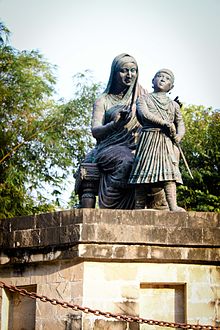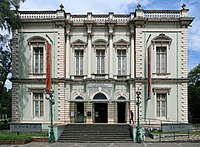| This article needs additional citations for verification. Please help improve this article by adding citations to reliable sources. Unsourced material may be challenged and removed. Find sources: "Jijamata Udyaan" – news · newspapers · books · scholar · JSTOR (September 2015) (Learn how and when to remove this message) |
| Jijamata Udyaan | |
|---|---|
 Statue of Jijamata and Shivaji at Jijamata Udyan (Byculla Zoo) Statue of Jijamata and Shivaji at Jijamata Udyan (Byculla Zoo) | |
| 18°58′41″N 72°50′12″E / 18.9781154°N 72.8367457°E / 18.9781154; 72.8367457 | |
| Date opened | 1861 |
| Location | Mumbai, India |
| Land area | 50 acres (20 ha) |
| Memberships | CZA |
| Jijabai Udyan & Zoo | |
|---|---|
| Type | Botanical Garden & Zoo |
| Location | Mumbai (Maharashtra) |
| Area | 50 acres |
| Founder | Dr. George Birdwood, Sir Jamsetjee Jeejeebhoy, Dr. Bhau Daji Lad, Hon. Jugonnath Sunkersett, Dr. George Buist |
| Owned by | Municipal corporation of greater Mumbai |
| Operated by | Director Zoo, MCGM, Mumbai |
| Visitors | 8000 to 30,000 (on holiday) |
| Status | Open |
| Species | 843 |
| Collections | Sundari(glass pane tree), Castanospermum australe, Coccoloba uvifera |
Jijamata Udyaan, also known as the Byculla Zoo and formerly Victoria Gardens, is a zoo and garden covering 50 acres located at Byculla, in the heart of Mumbai, India. It is the oldest public garden in Mumbai. After Indian independence, it was named after Jijamata, the mother of Shivaji, the first Maratha emperor.
In 1835, British administration granted a large plot of land in Sewri to the Agro Horticultural Society of Western India for a botanical garden known as Victoria Gardens after Queen-Empress Victoria. That land was later acquired for a European burial ground. In 1861, construction of a new garden was commenced on 33 acres in the Mount Estate, Mazgaon (now included in Byculla). The flora from Sewri garden was transferred to this new garden named Jijamata Udyaan which was formally opened to the public by Lady Frere on 19 November 1862. Agro Horticultural Society of Western India continued to maintain Victoria Gardens until 1873 when the society's end led to the municipal corporation taking over the garden's upkeep. In 1890 the garden was extended by 15 acres especially for the zoo.
The garden also houses the Dr. Bhau Daji Lad Museum, a staff building in Greco-Roman style erected in the memory of Lady Frere, and an equestrian statue of King Edward VII of England made of black marble (originally installed near the University of Mumbai) known as Kala Ghoda and the David Sassoon clock tower.
Updates
Just before few months 3 crocodiles and 2 alligators have been kept in these enclosures. A viewing gallery of approximately 1,500 square feet size has been set up in the zoo and from this platform, tourists and commoners can observe them on surface and underwater movements of the reptiles. A Japanese and butterfly garden are also recently opened, with snake and lion enclosures opening soon.
-
 The original Kala Ghoda
The original Kala Ghoda
-
 David Sassoon Clocktower
David Sassoon Clocktower
-
 Dr. Bhau Daji Lad Museum, Byculla
Dr. Bhau Daji Lad Museum, Byculla
Notes
- "Search Establishment". cza.nic.in. CZA. Retrieved 4 July 2011.
- "The varied flora of Rani Bagh's heritage botanical garden - Mumbai's largest green open public space". Save Rani Bagh Botanical Garden Foundation. Retrieved 3 February 2019.
- ^ "PLACES". Maharashtra State Gazetteers-Greater Bombay District. Archived from the original on 14 June 2011.
- ^ "Mumbai's Byculla Zoo: A testament to the period that shaped city's architectural landscape". The Indian Express. 1 May 2016. Retrieved 29 January 2021.
External links
| Pre-colonial | |
|---|---|
| Colonial |
|
| Beaches | |
| Places of worship |
|
| Cultural |
|
| Boulevards | |
| Districts | |
| Shopping |
|
| Buildings | |
| Parks, zoos and stadia | |
| Museums | |
| Forts |
|
| Restaurants & bars | |





